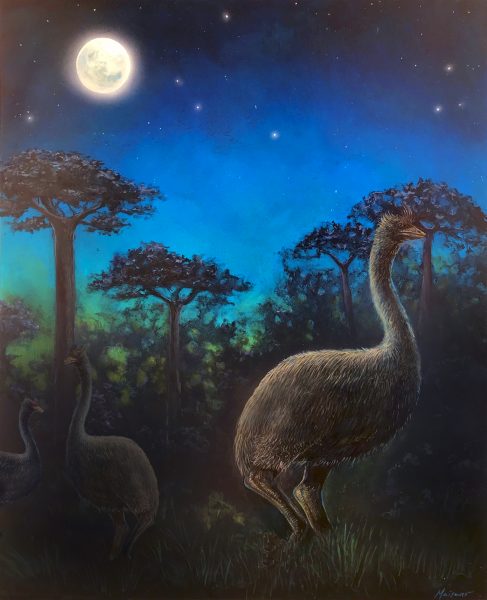Big and Blind
November 11, 2019

If you encountered an elephant bird today, it would be hard to miss. Measuring in at more than 10 feet tall, the extinct avian is the largest bird known to science. However, while you looked up in awe, it’s likely that the big bird would not be looking back.
According to brain reconstruction research led by The University of Texas at Austin, the part of the elephant bird’s brain that processed vision was tiny, a trait that indicates they were nocturnal and possibly blind. The findings were published Oct. 31, 2018, in the journal Proceedings of the Royal Society B.
A nocturnal lifestyle is a trait shared by the elephant bird’s closest living relative, the kiwi — a practically blind, chicken-size denizen of New Zealand — and a clue that is helping scientists learn more about the elephant bird’s behavior and habitat, said Christopher Torres, a Ph.D. candidate who led the research.
“Studying brain shape is a really useful way of connecting ecology — the relationship between the bird and the environment — and anatomy,” Torres said. “Discoveries like these give us tremendous insights into the lives of these bizarre and poorly understood birds.”
Julia Clarke, a professor in the Department of Geological Sciences at the Jackson School of Geosciences and Torres’ Ph.D. adviser, co-authored the study. Torres is a student in the UT College of Natural Sciences.
Elephant birds were large, flightless and lived in what is now Madagascar until a mixture of habitat loss and potential human meddling led to their demise between 500 and 1,000 years ago. Scientists had previously assumed that elephant birds were similar to other big, flightless birds, such as emus and ostriches — both of which are active during the day and have good eyesight. But Torres and Clarke revealed that elephant birds had distinctly different lifestyles by reconstructing their brains using CT-imaging data of two elephant bird skulls.
In both elephant bird skulls, the optic lobe, a bundle of brain nerves that controls eyesight, was very small, with the structure almost absent in the larger species. The lobe had the most in common with that of a kiwi,
which has poor vision and is nocturnal.
“As recently as 500 years ago, very nearly blind, giant flightless birds were crashing around the forests of Madagascar in the dark,” Clarke said. “No one ever expected that.”
Back to the Newsletter